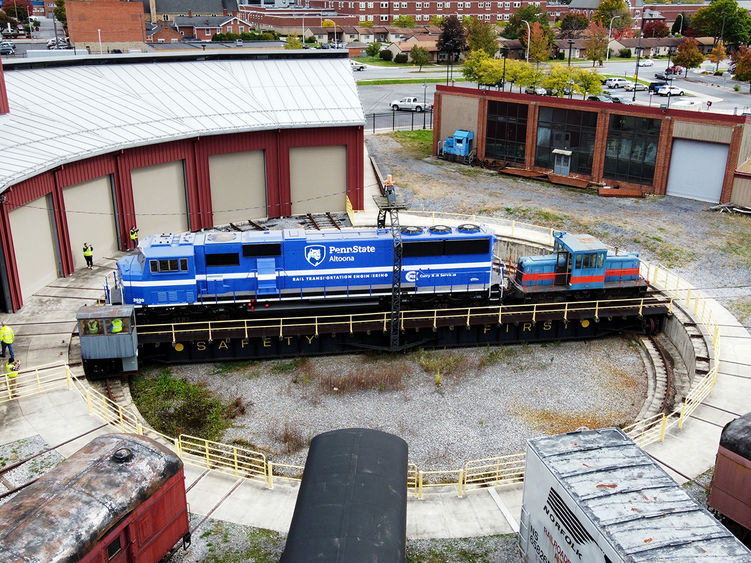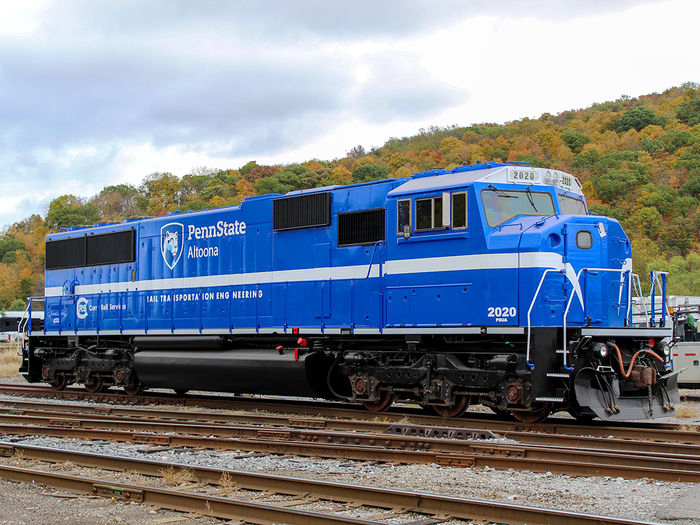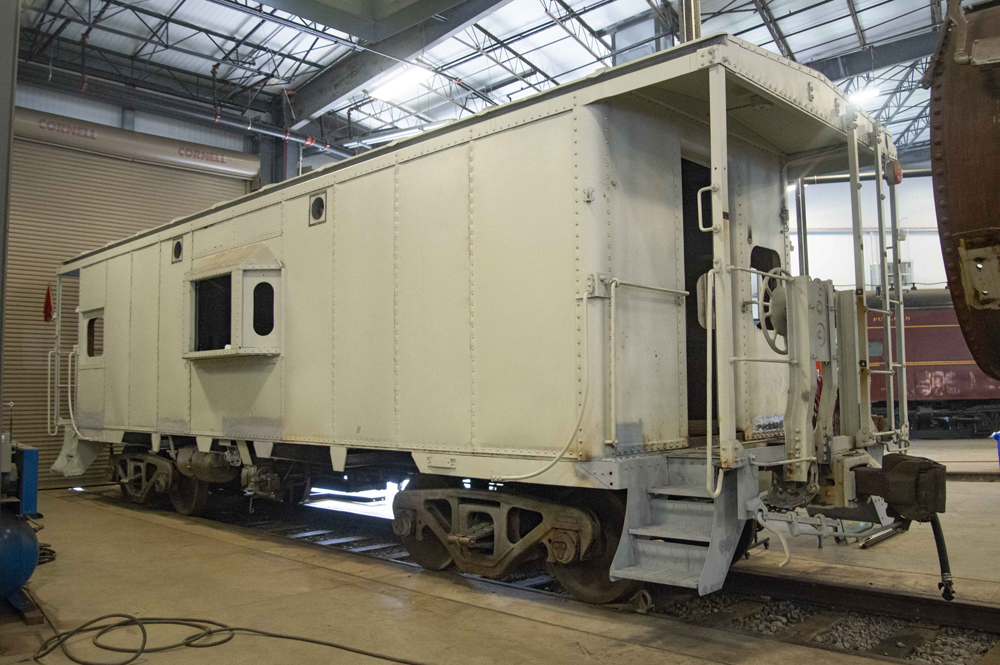
ALTOONA, Pa. – The Altoona Campus of Penn State University has donated a former Conrail SD60I road freight locomotive to the Railroaders Memorial Museum for continued use by undergraduate engineering students.
Recently moved into the museum, the 3,800-horsepower unit is now available for public viewing in the Harry Bennett Memorial Roundhouse, near the restoration work on Pennsylvania Railroad K4s 4-6-2 steam locomotive No. 1361.
Built by Electro-Motive Division in 1995, the 197-ton unit began life as Conrail 5582, then was renumbered Norfolk Southern 6721 when NS bought a 58%stake in Conrail in 1998-99. After retiring the unit in 2019, NS donated it to PSU for the Altoona Campus’s Rail Transportation Engineering program. Penn State renumbered it 2020 for the year it was donated.
Only Conrail purchased the SD60I (I signifying “Isolated”) model, a variant of the SD60 that employed a vibration- and sound-reducing cushion or “donut” under the wide-nose cab in an effort to render the crew environment less noisy than those of a standard SD60M or a spartan-cab SD60. Dubbing the model the “Whispercab,” EMD built 81 units (CR 5544, 5575-5654). Of these, Nos. 5595-5614 and 5630-5654 were assembled at Conrail’s Juniata Locomotive Shop in Altoona. At first, crews reported that they were noticeably quieter but over time and with inadequate maintenance, the rubber gaskets deteriorated, giving the units a reputation as hard-riding.

No. 2020 had been stored at Curry Rail Services, a contractor in nearby Hollidaysburg, Pa., that occupies a portion of the former PRR Samuel Rea Car Shop. Before donating it to PSU, NS refurbished it at Juniata Locomotive Shop, including installing new wheels and traction motors, and Positive Train Control gear.
It was then mothballed and drained of all fluids, so it is not operational, but could be reactivated at any time. Curry donated the paint job, which is a medium blue — in between PSU dark blue and Conrail blue — with Penn State graphics, including the school’s Nittany Lion mascot, in white.
Museum Executive Director Joe DeFrancesco explained the reason for the transfer of ownership and location.
“For the purpose of being a stationary mechanical lab, it became apparent that it was not in an ideal location for [student] accessibility for the program,” he said. “As the museum restructured and reprioritized with some retired NS people being on both the RTE advisory board and the museum board, there was interest in having the mechanical lab at the museum. PSU does not have a rail facility of its own, and this helps the museum build its educational mandate.
“The 2020 is the first step in [a] strategic partnership in fulfilling that educational mandate,” he said, noting that the museum envisions setting up labs for welding, air-brake technology, signals, track, and passenger and freight-car technology.
“Ideally the museum will be the host, and Penn State will be the educational institution providing those opportunities,” DeFrancesco said. “What’s needed is capital improvements to the roundhouse, the involvement of industry in input in terms of courses, as well as assets and gifts to be used to invest in the facility, and assets in terms of equipment for teaching tools.” A $500,000 state grant, with a needed matching amount of other funds, will aid in reaching this goal.
The connection between college engineering classes and railroads has a long and colorful history. A century ago, Penn State, Purdue, the University of Illinois, Iowa State University, and Columbia University all owned and operated steam locomotives as part of their engineering curriculum, either on the road or on stationary test plants. Railroads often loaned mechanical officers to serve as visiting classroom lecturers. In addition, civil and mechanical engineering undergrads from PSU’s main campus at State College, Pa., and other schools regularly visited PRR’s Altoona Test Plant, which operated a locomotive test facility 1906-1955 about a block from the museum’s current location.
Started in 2011, Penn State Altoona’s program has a 100% placement record of graduates finding employment in the railroad industry.
DeFrancesco said he hopes that No. 2020 “ushers in future generations of railroaders that will come to the museum, to learn about railroading basics and engineering courses in a setting that will [let them] gain an appreciation of the heritage – past, current and future.”
Penn Central caboose restoration

The museum also recently announced a partnership with the Penn Central Railroad Historical Society in which the group will give and raise as much as $10,000 to complete the restoration of a former PC Class N10 bay-window cabin car (caboose). One of the last 50 to be built in the Altoona car shops, it came to the museum in 2006 as Conrail No. 24026.
To date, the Horseshoe Curve Chapter of the National Railway Historical Society has spent about $8,000 to advance the work, which consists mostly of sheet-metal work to rebuild the ends, removing the interior, and rebuilding the bay windows, as well as overall sandblasting and priming.
On Sept. 23, the Penn Central society board voted to donate $5,000 and to initiate a $2,500 matching-gift campaign to bring the total up to $10,000. Much of the exterior restoration is well along, leaving interior work, general backdating to 1969, and finishing the car in PC green with white markings as some of the remaining tasks. Work is being done by museum and Penn State volunteers. When the car is completed, the museum expects to make it available for interactive programs and short tours on the grounds.
Donations to the matching campaign, open till Feb. 1, 2024, can be made here.
NS gift and employee free admission
Norfolk Southern has donated $50,000 to the museum’s general fund and in exchange, as of Monday, Nov. 6, the museum is offering all NS employees and retirees free regular admission for the remainder of 2023 and all of 2024, including selected special events, and a one-year membership. With presentation of ID, this offer is good at both the main campus at 1200 Ninth Ave. in downtown Altoona and the nearby Horseshoe Curve National Historic Site.
While the offer most benefits NS employees in Western Pennsylvania, it’s open to any of the railroad’s staff of 20,000 persons who might be visiting the area.
— Updated at 9:55 a.m. CST to correct photo credits on SD60I images.













PSU Altoona offers a Bachelors Degree in Electro-Mechanical Engineering Technology. Per their website, “EMET graduates combine the fundamental principles of both electrical and mechanical engineering to design, develop, manufacture, and test computer-controlled mechanical systems.”
With NS’ Altoona Shops right in town as well.
Want something more theoretical for your Masters? PSU Main Campus is 50 miles away.
This is great news and a positive step to getting the younger generation and young people into the railroad industry with regards to engineering and building and repairing locomotives as well as designing new equipment. If railroading is to survive and grow, younger people must be encouraged and given all the support and tools needed to train and educate them in development of new motive power as well as design and planning. If young people can work and design computer technology and software and build and design new space equipment and of course design new automobiles that are energy efficient and ecco friendly, there shouldnt be any problem or issues with the training and hiring of future generations to work in the rail and transit industry. As a side note, we also need the younger generation and young folks to get involved with rail preservation and history as well. There are a handful of young people doing this now as well as volunteer groups in a few colleges but more needs to be done. Our present group of rail entusiasts and railfans as well as the present group of railroaders are not getting any younger but each year get older and soon enough disappear into eternity taking with them the knowledge, the history and love and lore of trains and railroading. Young folks are the key to reinvigorating the railroad industry and hobby with new and fresh ideas, planning and enthusiam and a totally new perspective of keeping trains and railroads rolling for future generations to come
Joseph C. Markfelder
Whoops! PRR and PC never owned any “cabooses”. They were cabins or cabin cars on both roads! (“Vans” on NYC).
That term is in there in the body of the story, Al, but if we used either ‘cabin’ or ‘cabin car’ in the headline, I would argue a lot more people would not know what it meant. — David Lassen
Dear cabooses are gone, but they are not forgotten!
Dr. Güntürk Üstün
Oops sorry David, I missed it!
Great news! Items are restored and employment in the industry is also promoted as a career path.
Great work by everyone involved!
That’s it! A great teamwork!
Dr. Güntürk Üstün